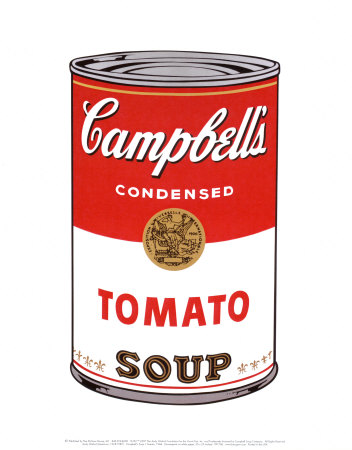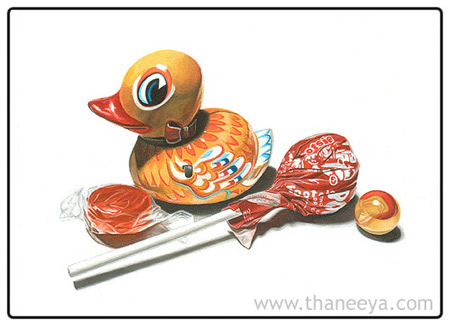Still life paintings and drawings
Still life is defined as a collection of inanimate objects arranged together in a specific way.
The magic of still life paintings is that they can show us a new way of looking at the ordinary objects around us. Once they are placed into a specific arrangement and then captured in paint, ink, pastel, or any other medium - the objects take on a whole new meaning. They are imbued with a life beyond the ordinary. Their existence becomes recorded in time.
Andy Warhol's Campbell soup cans. No doubt you have seen this famous Pop Art image at some point during your lifetime. Take an ordinary soup can - it's just an everyday object that you wouldn't think twice about as you drop it into your shopping cart. But Warhol's treatment of the subject matter made the soup can colossal, larger than life, an image to be reckoned with!
The objects chosen for a still life painting often have a special meaning, either on a personal, cultural, societal, religious or philosophical level. The themes surrounding the artwork often provoke introspection and reflection in the viewer. The way that the objects are depicted can evoke a wide variety of emotions, depending on their arrangement, as well as the lighting, color choice, and handling of the paint. These are all things to take into account when viewing a still life artwork. They are especially important to consider when you are creating one.
I know that's a lot of information to throw at you at once! Don't worry, we'll examine each of these points further.
Subject matter
The subject matter of still life paintings is determined by the objects that are portrayed in the paintings. Discover some of the natural still life objects that appear in famous still life paintings throughout history! Explore the symbolism and meaning of these objects, with still life examples.
Meaning & Themes in Still Life Art
When looking at a still life painting, or when creating one, the most important thing to ask yourself is, "What does it mean?" Is it a random collection of items, or did the artist have a particular intention when choosing them? It's easy to look at a painting and think, "Hmm, pretty objects", and quickly move on to the next painting. But the artwork usually goes much deeper than just depicting pretty objects. Even if a piece is purportedly meaningless, there is always an underlying thought process behind the work. (And if you want to look at art intelligently, it's important to examine the artwork with an investigative eye and an inquisitive mind!)
The themes for a still life painting can be personal, cultural, societal, mythological, religious or philosophical and existential. Or, they can be based on material qualities, such as color or texture. They can even be whimsically based on objects that start with the same letter of the alphabet, or things you might find in a typical junk drawer in someone's kitchen. And of course, all of these themes can overlap to weave a richly layered tapestry of theme and meaning within a single artwork!
A quick jaunt through time:
Historically, still life paintings were deeply imbued with religious and mythological meaning. This was a reflection of the times; the Church was the center of everyday life. Class hierarchy was deeply embedded - everyone knew their place and stayed within it. By the 16th century, society was changing. As science gained more of a stronghold, religious themes fell by the wayside. The natural world was now interesting to observe and record in its own right, not for religious or mythological purposes. As history rattled towards the mid-19th century, depicting the natural world was starting to go out of fashion. Now the art world was more interested in exploring our inner world of moods and emotions. As we sped through the 20th century, still lifes dissolved into geometry as objects were abstracted more and more on the canvas. By the end of the millenium, the object depicted in paintings were exhalted as commodity and recognized for their commercialism, as in the Pop Art and Photorealism movements.
Analyzing a Still Life for Meaning
If you're not exhausted after quickly careening through the history of the still life as an art form, let's close this section by examining how one of my paintings, Yellow-Orange, encompasses a few different themes.
What is this painting about? Well, let's take a closer look. There are four objects in the painting: a toy duck, a candy in a clear plastic wrapper, a Tootsie Pop, and a shiny marble. What do they have in common? Well, the most obvious shared trait, also echoed in the title of the piece, are the predominating colors of yellow and orange. These are a variety of different objects that all share a similar color scheme, so they work well together visually.
Is that all they have in common? Let's examine their function - what are they used for in everyday life? Two pieces of candy and two toys... Hmm, these objects signify childlike fun! The candies give great pleasure, and the toys bring great joy... when they are used, that is. In this painting, they are a collection of objects sitting still against a stark white background. They symbolize the potential for future fun, as well as conjure up memories of past fun. In the present, they are just simply there. Simply being.
And what about that stark white background... what does it mean? Well, ask yourself: what does the white background cause my eyes and mind to do? Basically, the white background forces you to focus your direct attention on the objects. They are almost, but not quite, floating in space - they still have subtle shadows, which define their place in space. In my view, the white background helps these items become more iconic. That is, they represent stereotypical emblems of childhood. They are timeless and unattached to a specific location. They could be anywhere. They could even be drifting in the white cloud of your imagination.
This is one way of interpreting the painting. There is more that I could say about it, but for now, this will suffice. Remember that this is just one interpretation though. You could say that it is the interpretation; that since I am the artist, my word is the final word, case closed. Not true, however. Art is meant to be shared. It is a form of communication, and as such, the story doesn't end when the brush leaves the canvas. It is only just beginning.
When a viewer looks at a work of art, they are bringing with them all of their life experiences, all of their unique memories, all of their knowledge and understanding of the universe thus far. Their mind interacts with the artwork as their eyes travel over the piece. What I experience when I look at a certain artwork will not be exactly the same as what someone else experiences when looking at the same piece. Therefore, what I create will not always be interpreted by others in the same way as I intended. There is always a mysterious gap between intention and interpretation, and such is the beauty of communication.
Read More
Learn why artist Giorgio Morandi is Italy's most famous 20th century still life painter! See Giorgio Morandi still life paintings, whose timeless quality captivates art enthusiasts.
Learn how to paint flowers with amazing classical realist artist, Delmus Phelps! Read an in-depth interview and view his breathtaking flower paintings of roses, daffodils, magnolias and more.
Ready to draw your own still life? Check out this photorealistic art lesson and learn how to draw a marble in colored pencil!
As an Amazon Associate, I earn from qualifying purchases at no additional cost to you.











